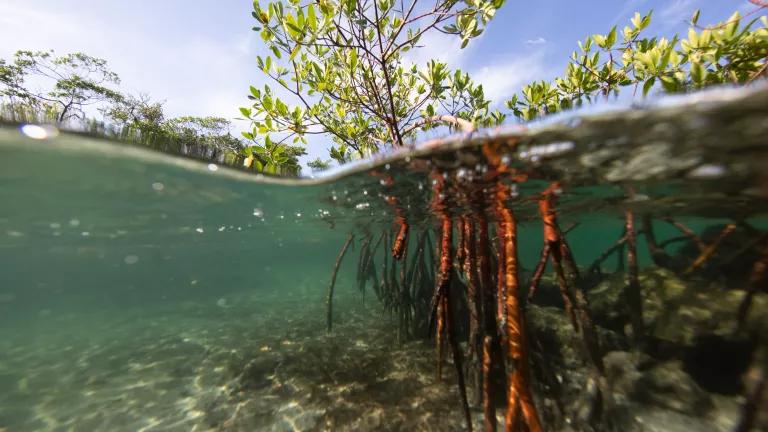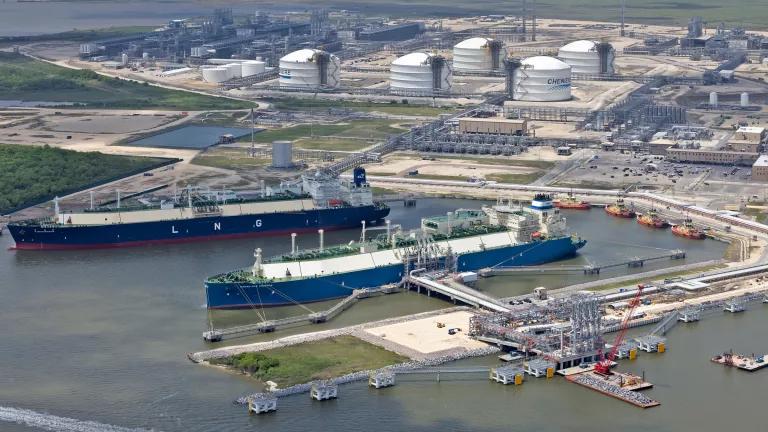Blue Carbon Can Help Climate Change "Code Red"
Advancing nature-based solutions—such as protecting and restoring blue carbon ecosystems in Latin America and beyond—must be an integral part of global climate action.

A view of mangroves above and below saltwater. Mangroves have roots that are slightly exposed, which allow for sediment trapping and protect the shoreline from erosion.
Guest blog written by Tareen R. Haque. Tareen is an undergraduate student at Macaulay Honors College at the City University of New York (CUNY), majoring in Environmental Earth Systems Science. This summer, she worked closely with NRDC’s Latin America team and analyzed nature-based solutions as a means of climate change resilience. Tareen is also the co-president of Macaulay Green Initiative, a sustainability club in her school, and was previously a Climate Policy Fellow at the Colin Powell School for Civic and Global Leadership in CCNY.
Global warming is escalating even faster than we thought.
According to the recent IPCC Report, the global average temperature will approach and exceed the 1.5 degrees Celsius temperature threshold in the next century. Crossing the temperature threshold projects more intense climate hazards, such as sea levels drastically rising. The new report demonstrates that the urgency to reduce greenhouse gas emissions is higher than ever. With the climate crisis constantly making headlines, it is of the utmost importance to seize every opportunity, including nature-based solutions, to mitigate emissions and strengthen the resilience of communities.
The projections of global warming make it clear that it is crucial for countries to commit to 30x30, a plan to protect 30% of the world’s ocean and 30% of global land and inland waters. Protecting and conserving the oceans and land can help address the rapidly increasing amount of atmospheric carbon, sustain critical biodiversity, and strengthen the resilience of communities. Nature-based solutions also present the opportunity for carbon sequestration, allowing for the removal and storage of carbon from the atmosphere. For instance, protecting and restoring blue carbon ecosystems offers a means of carbon sequestration.
What are Blue Carbon Ecosystems?
Defined as rich coastal ecosystems, blue carbon ecosystems, such as tidal marshes and mangroves, are useful for storing carbon dioxide and can aid in reducing the effects of climate change. Based on current assessments, the carbon sequestration capacity of these ecosystems appears promising. These natural areas can also provide numerous ecosystem services, such as areas for fish spawning and nursing. Initiatives like the Blue Carbon Initiative develop projects to conserve and restore existing blue carbon ecosystems.
As one of the coastal ecosystems that support blue carbon, mangroves forests serve as important carbon sinks, since they have the ability to store at least three times as much carbon as terrestrial tropical forests. Apart from this, they also offer resilience to climate change impacts since the trees and roots provide shoreline protection from extreme weather and erosion. Sediment trapping in the roots also shields soil from erosion, which is likely due to friction preventing tidal flow. In a study with simulated models of mangroves in Bangladesh, the Keora mangroves, one of the tallest mangrove species in the Sundarbans Reserve Forest, drastically reduced local seawater rise, with estimates ranging from 4 to 16.5 centimeters.
In Latin America, blue carbon programs are still an emerging solution to carbon dioxide removal. Despite their benefits, mangroves are often not sufficiently protected and are destroyed. Recently, Mexican state-owned oil company Pemex cut down protected mangrove forests for the construction of the Dos Bocas Oil Refinery. Despite a pre-existing commitment to protect environmental goods from Mexico’s Agency for Safety, Energy, and Environment, and the possibility of gaining $1.19 billion from restoring mangroves, mangrove protection has not been appropriately prioritized. In Brazil, mangroves aren’t being protected either. In a controversial decision by the current Brazilian administration, mangrove and coastal ecosystem protections have been revoked, leading to pollutant retention and increased environmental vulnerabilities.
So why aren’t these tropical ecosystems actively supported despite the many benefits?
In general, one of the reasons there aren’t more blue carbon initiatives implemented globally is because there is not enough research to understand the advantages of blue carbon. Analyzing blue carbon ecosystem management can create new opportunities for carbon dioxide removal and sustainable ocean development. Besides that, industrial development is frequently prioritized over marine ecosystem conservation. Planning blue carbon projects thoroughly and efficiently is critical. These projects need to consider changing climate conditions, to prepare for future potentialities like increased salinity in the water. Developing models and investigating how variability and carbon chemistry affect environmental tolerance can also unearth the key to successful blue carbon ecosystems.
A Blue Future
Advancing nature-based solutions—such as protecting and restoring blue carbon ecosystems in Latin America and beyond—must be an integral part of global climate action. Investing in research will create opportunities to expand blue carbon management and protection by offering guidance and techniques for project success. By supporting research efforts, countries can identify the tools necessary to protect, restore, and conserve nature for climate change mitigation and adaptation. Beyond advancing blue carbon research proficiency, countries should include nature-based solutions in their Nationally Determined Contributions (NDCs). Financing and developing nature-based solutions to adapt to climate hazards can be extremely beneficial for humans and the environment. Community-led nature-based solutions can tackle biodiversity loss and promote sustainable development for local groups.
Though the recent IPCC report stressed a code red for the climate crisis, there is still a potential for decelerating global warming and reducing the impacts of climate hazards. At COP26, government leaders must commit to rapidly reducing greenhouse gas emissions from energy generation, transportation and deforestation. It’s also imperative that they commit to advancing nature-based solutions to ensure a sustainable future that averts climate catastrophes.




